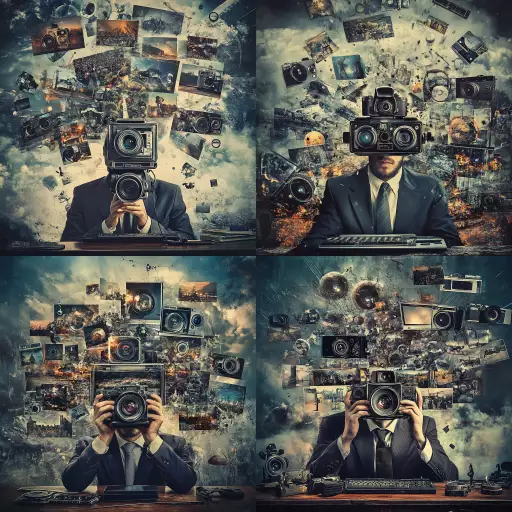Explore the Best AI Image Gallery

Blockchain Beyond Finance: Unlocking Creative Potential in the Digital Age
Blockchain technology, renowned for its disruptive influence on finance, is rapidly extending its reach into diverse sectors, including the dynamic world of creative industries.
While its applications in areas like cryptocurrency and smart contracts are well-established, blockchains potential to revolutionize how creatives produce, distribute, and monetize their work is just beginning to be explored.
Potential Uses in the Creative Industry
- Copyright Protection and Ownership: Blockchain offers an immutable ledger that can record ownership of creative works, ensuring transparency and preventing plagiarism.
- Digital Rights Management (DRM): Smart contracts on blockchain can automate licensing agreements and royalty payments, empowering creators to control their intellectual property.
- NFT Marketplace for Unique Assets: Non-fungible tokens (NFTs) enable the creation of verifiable digital scarcity, facilitating the sale and trading of unique creative assets like artwork, music, and collectibles.
- Decentralized Content Distribution: Blockchain can facilitate peer-to-peer content sharing, bypassing traditional intermediaries and empowering creators to reach wider audiences directly.
- Collaborative Creation Tools: Blockchain-based platforms can enable real-time collaboration on creative projects, fostering innovation and shared ownership.
Ethical Considerations
While blockchain presents exciting possibilities for the creative industry, it also raises ethical considerations that require careful consideration:
- Accessibility and Inclusion: Ensuring equitable access to blockchain technology and its benefits across diverse communities is crucial.
- Data Privacy and Security: Balancing transparency with user privacy concerns is essential in blockchain-based systems.
- Environmental Impact: The energy consumption associated with some blockchain networks requires attention to minimize environmental footprint.
- Copyright Infringement: While blockchain can aid in copyright protection, its important to address the potential for misuse and ensure ethical practices.
- Algorithmic Bias: Blockchain-based systems can perpetuate existing biases if not carefully designed and monitored.
Future Trends
The intersection of blockchain and the creative industry is poised for continued evolution. Here are some anticipated trends:
- Integration with Metaverse Platforms: Blockchain will likely play a key role in securing and monetizing digital assets within virtual worlds and metaverse experiences.
- Advancements in Decentralized Autonomous Organizations (DAOs): DAOs could empower creative communities to collaborate, make collective decisions, and manage intellectual property collectively.
- Cross-Industry Collaboration: Blockchains versatility will likely drive partnerships between the creative industry and sectors like entertainment, gaming, and fashion.
- Greater Transparency and Traceability: Blockchain will enable more transparent supply chains and provenance tracking for creative products and services.
- Evolving Legal Frameworks: As blockchain technology matures, legal frameworks will need to adapt to address the unique challenges and opportunities it presents for copyright, intellectual property, and artistic ownership.
Blockchain technology holds immense potential to transform the creative landscape, empowering artists, fostering innovation, and redefining how we interact with and value creative content in the digital age.
















](https://images.ai-img.art/thumbnails/150/51c93500396faff4e7fa8b42bc68033067b16b2230e3496e95c482a581ff0fe9.webp)
](https://images.ai-img.art/thumbnails/150/9d51c5e673b4f2068b7b01abc35425a06f173b76303adf9ad29ca14302c25b18.webp)




![**Representation: A dog acting as a private tutor to a child. The dog holds a ruler in its paw and stands at the blackboard to explain a dog diagram to the child. Graphic style: Line drawing, cartoon style, influenced by Franco-Belgian comics, thick black lines, simplified design, vector, black and white only, in the style of Keith Haring or the French comic strip "Alinéa". [IMPORTANT]: A single continuous line extending from one side of the image to the other, minimalist, strong outlines, line drawing, without lifting the hand, ultra-simplified, no shading, entirely white image, drawing created in the center of a sheet of paper. --ar 16:5** - Variations (Strong) by <@627984126871470085> (fast)](https://images.ai-img.art/thumbnails/150/f4e034998ccd869d8a061fd12017514fcd92210eb33d4222dc9b54716223f4dd.webp)
](https://images.ai-img.art/thumbnails/150/157712d76865d557120f9baf988de3d0525225295a2789c89bf2c4a5a96a03d1.webp)


![**Representation: A teenager smiling while thinking about a friendly dog, a comic-style thought bubble with a friendly dog inside. Graphic style: Line drawing, cartoon style, influenced by Franco-Belgian comics, thick black lines, simplified design, vector, black and white only, in the style of Keith Haring or the French comic strip "Alinéa". [IMPORTANT]: A single continuous line extending from one side of the image to the other, minimalist, strong outlines, line drawing, without lifting the hand, ultra-simplified, no shading, entirely white image, drawing created in the center of a sheet of paper. --ar 16:5** - <@627984126871470085> (fast)](https://images.ai-img.art/thumbnails/150/6fc850f638e3dee0c4b121acecad2c8419e02bdeac7f871d625f1003c1c3abe1.webp)


![**Representation: A dog acting as a private tutor to a child. The dog holds a ruler in its paw and stands at the blackboard to explain a dog diagram to the child. Graphic style: Line drawing, cartoon style, influenced by Franco-Belgian comics, thick black lines, simplified design, vector, black and white only, in the style of Keith Haring or the French comic strip "Alinéa". [IMPORTANT]: A single continuous line extending from one side of the image to the other, minimalist, strong outlines, line drawing, without lifting the hand, ultra-simplified, no shading, entirely white image, drawing created in the center of a sheet of paper. --ar 16:5** - <@627984126871470085> (fast)](https://images.ai-img.art/thumbnails/150/7a854648a81e51241dcca8d24dd6e3bfcf07ad1df51baf401c9b729f4cf411fa.webp)














